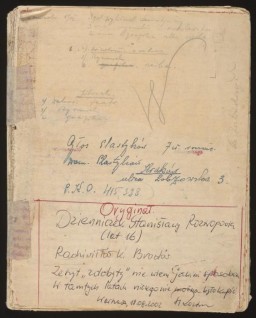
Artifact
Browse an alphabetical list of artifacts from the Holocaust and World War II. Each object tells a story about the history and demonstrates human experiences during the time period.
<< Previous | Displaying results 1-14 of 14 for "Artifact" | Next >>
-
Candlesticks taken to Vilna by Polish Jewish refugees
ArtifactA pair of candlesticks, bought in Poland and used every Friday evening during observance of the Jewish Sabbath. Polish Jewish refugees fleeing the German invasion of Poland in 1939 carried these candlesticks with them to Vilna.

-
Casting of Majdanek gas chamber door
ArtifactThis casting of a gas chamber door in the Majdanek camp, near Lublin, Poland, was commissioned by the United States Holocaust Memorial Museum. Each gas chamber in Majdanek was fitted with an airtight metal door and was bolted shut before gas entered the chamber inside. SS guards could observe the killing process through peepholes in the upper center of the door.
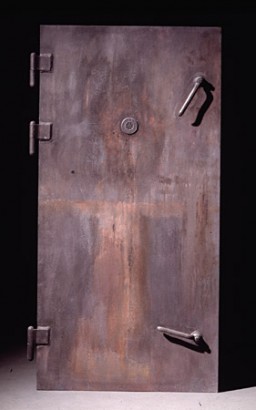
-
Chart of Prisoner Markings
ArtifactA chart of prisoner markings used in German concentration camps. Dachau, Germany, ca. 1938–1942. Beginning in 1937–1938, the SS created a system of marking prisoners in concentration camps. Sewn onto uniforms, the color-coded badges identified the reason for an individual’s incarceration, with some variation among camps. The Nazis used this chart illustrating prisoner markings in the Dachau concentration camp.
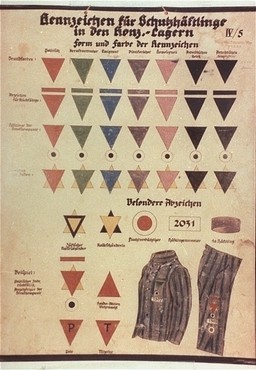
-
Children's art: Drawing of people in a garden
ArtifactAlice Goldberger (1897-1986) was born in Berlin, Germany. Trained as a youth-work instructor, she ran a shelter for disadvantaged children and their families. When Hitler came to power, Alice, who was Jewish, had to give up her post. She immigrated to England in 1939. When war broke out, Alice was interned on the Isle of Man as an enemy alien. While there, she organized a children's facility.Hearing of Alice's work in the camp, psychoanalyst Anna Freud (daughter of Sigmund Freud) intervened to secure her…

-
Children's art: Handmade comic book "To Alice from Ervin Bogner"
ArtifactAlice Goldberger (1897-1986) was born in Berlin, Germany. Trained as a youth-work instructor, she ran a shelter for disadvantaged children and their families. When Hitler came to power, Alice, who was Jewish, had to give up her post. She immigrated to England in 1939. When war broke out, Alice was interned on the Isle of Man as an enemy alien. While there, she organized a children's facility. Hearing of Alice's work in the camp, psychoanalyst Anna Freud (daughter of Sigmund Freud) intervened to secure…
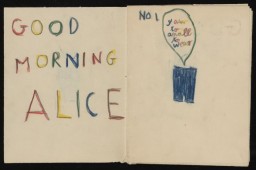
-
Children's art: "Lav Fritz," handmade pamphlet of drawings by Fritz Friedmann
ArtifactAlice Goldberger (1897-1986) was born in Berlin, Germany. Trained as a youth-work instructor, she ran a shelter for disadvantaged children and their families. When Hitler came to power, Alice, who was Jewish, had to give up her post. She immigrated to England in 1939. When war broke out, Alice was interned on the Isle of Man as an enemy alien. While there, she organized a children's facility. Hearing of Alice's work in the camp, psychoanalyst Anna Freud (daughter of Sigmund Freud) intervened to secure…
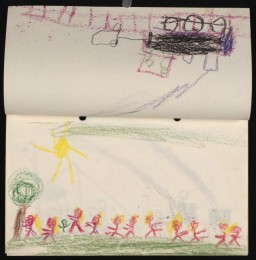
-
Children's art: Lingfield House diary
ArtifactAlice Goldberger (1897-1986) was born in Berlin, Germany. Trained as a youth-work instructor, she ran a shelter for disadvantaged children and their families. When Hitler came to power, Alice, who was Jewish, had to give up her post. She immigrated to England in 1939. When war broke out, Alice was interned on the Isle of Man as an enemy alien. While there, she organized a children's facility. Hearing of Alice's work in the camp, psychoanalyst Anna Freud (daughter of Sigmund Freud) intervened to secure…

-
Child's Sweater Worn in Hiding
ArtifactDuring the 1943 liquidation of the Lvov ghetto, dozens of Jews fled into the city sewers to escape death. Eight-year-old Krystyna Chiger (later Kristine Keren) hid with her family and 16 others beneath the city's streets for 14 months, during which she wore this sweater.

-
Comb made by Yona Wygocka Dickmann
ArtifactYona Wygocka Dickmann fashioned this aluminum comb from airplane parts after the SS transferred her from Auschwitz to forced labor in an airplane factory in Freiburg, Germany, in November 1944. She used the comb as her hair, shaven in Auschwitz, began to grow back.
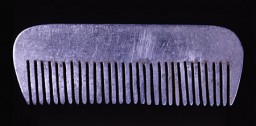
-
Contact print booklets
ArtifactTwo of Julien Bryan's Nazi Germany 1937 contact print booklets of still photographs organized by camera roll. Bryan used these prints to select and crop images for publication or distribution and annotated the covers.
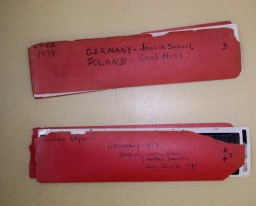
-
Courtroom Sketch of Elie Wiesel at the Trial of Klaus Barbie
ArtifactCourtroom sketch by artist David Rose of Nobel laureate and Holocaust survivor Elie Wiesel on the witness stand at the trial of Klaus Barbie. During his testimony, Wiesel stated that "The killer kills twice. First, by killing, and then by trying to wipe out the traces." June 2, 1987.
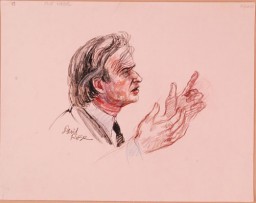
-
Cover, International Military Tribunal program
ArtifactCover of a mimeographed program booklet distributed at the International Military Tribunal at Nuremberg.
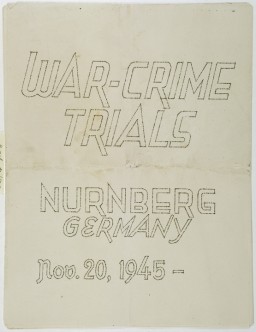
-
Cover of a Japanese-German phrase book
ArtifactGerman Jewish refugees purchased this Japanese-German phrase book shortly after their arrival in Japan. Japan, 1940-1941. [From the USHMM special exhibition Flight and Rescue.]

-
Cover of Stanislava Roztropowicz's diary
ArtifactStanislava Roztropowicz kept a diary from 1943-1944. In it, she describes her family's decision to hide an abandoned Jewish girl, Sabina Heller (Kagan). Sabina Kagan was an infant when SS mobile killing squads began rounding up Jews in her Polish village of Radziwillow in 1942. Her parents persuaded a local policeman to hide the family. The policeman, however, soon asked the Kagans to leave but agreed to hide baby Sabina. Her parents were captured and killed. Sabina was concealed in a dark basement,…
